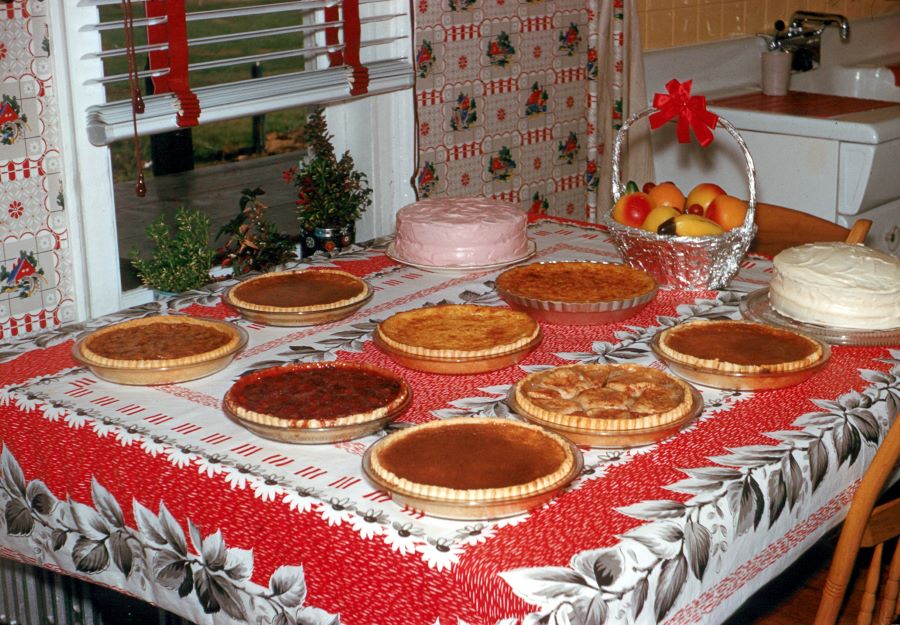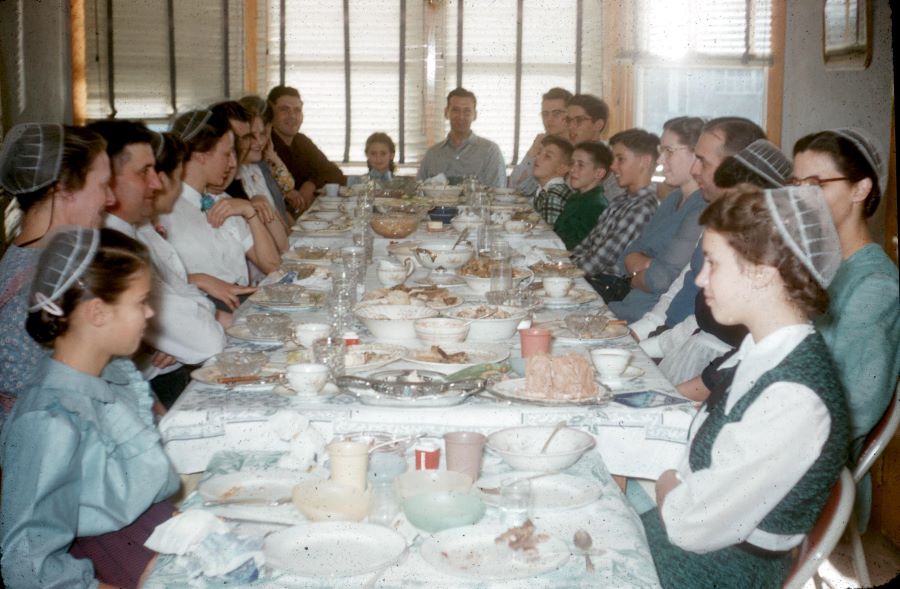By John Ruth.
Title image: Dinner at the home of Marcus & Helen Clemens, circa 1952. Courtesy of John Ruth.
The tradition of Sunday dinner with guests, thriving in our Mennonite (and larger) community as late as the early 1970’s, was an expression of a communal spirit. It was an equally culinary and sacramental Sabbath experience. Now, except among the Plain People, it has been largely done in by individualism, business and restaurants.
Born in January 1930 in a threefold household of grandparents, parents, uncle and aunt and cousins, I was immersed in the Sunday dinner tradition. For the previous two decades my grandmother, now approaching sixty, had been keeping a diary whose main features were church-going and “company,” mostly “for [Sunday] dinner.” For the seven weeks after my birth, when I and cousin Gladys Landis had the whooping cough, company was limited to non-mealtimes. Then, as normalcy returned, by August my grandmother recorded fifteen “dinners” with company at home, and an equal amount as company at other homes.
Counting homes I remember eating “Sunday dinner” in from here to Lancaster County, I easily surpass 100 – and those are just the ones I remember. Of course, as a minister, I and my family were invited more than usual, especially when I was preaching in congregations other than our own. It was always a wonderful experience to be treated with a good housekeeper’s best recipes, shared in jovial hospitality.

Invitation to Sunday dinner
Our Heritage Center archives preserve postcards inviting relatives and friends for an approaching Sunday. Sometimes, of course, the telephone served thus. And often the invitation was a Sunday-morning-after-church surprise, when visitors were noticed, or there was a visiting preacher’s family. It was easier when the visitors were only a couple; one thought twice when the preacher and wife had nine children, as did the John and Edith Lapp family. (My wife, one of eleven children, remembers that though her family often had company for Sunday dinner, they were understandably not usually invited by other families.) When there were too many to serve together, there was sometimes a “second table” for the hungry older children.
Once my siblings and I were embarrassed when, as we visited a neighboring Mennonite church, our mother invited herself and family to the home of an old friend. This of course was with the knowledge that it was normal to have canned sausage, chicken or beef in the cellar for such emergencies.
Awaiting dinner
The men and boys and some of the other guests lounging in the living room or “parlor” could be made weak in the knees by the promising aroma of roast beef. A metallic knocking signaled that potatoes were being mashed. Sometimes the hostess would put on a fresh apron. One Mennonite woman used to tie her apron strings in the front, making a neat bow before slipping it around to her back.
Then would come the call, followed by the men taking off their coats, and a flurry of choosing among the miscellany of chairs around a table that sometimes stretched room-length. Elbow room could be as minimal as in an airliner.
Silent grace
“Now children, put your hands down.” The long unannounced silence concluded only with the audible intake of breath by the host. “Now just reach and help yourselves,” said the hostess, who often remained standing at the kitchen-end of the table. “I don’t want anybody to go hungry.”
Dinner menu
Roast beef was perhaps the standard entree, sometimes supplemented with chicken. The latter was not the favorite of poor Elias W. Kulp, the much-traveled minister at Bally. When he preached a week of revival meetings, he said, the best possible scenario for him was when there was chicken on the first Sunday, and sewing circle on Monday. That way all the women knew that he couldn’t enjoy chicken.
The mashed potatoes (sometimes supplemented with sweet potatoes) of course required gravy. In summer there was leaf lettuce with sweet-sour milk and hard-boiled eggs. Peas, carrots and succotash were common; in the winter there was dried corn. For sours there might be pepper cabbage, piccalilli (some called it chowchow), red beets or canned artichokes, applesauce,
“Mom, the bean dish is empty,” I heard a Plain preacher say in Dutch. “Mem, die bohne schlissel iss leer.”
It was our lot to have a father with distinct personal tastes, and definite limits to acceptable menus. This was, of course, fine at home, but when we were visiting it could be an issue. I remember one Lancaster County hostess being visibly dismayed when my father passed up the delicious bounty before us, choosing instead to consume a sequence of slices of jelly bread.
Desserts
It may seem strange, but there was often a profusion of desserts, with both cake and pie, two kinds of pudding (rice and tapioca), and canned sweet (yellow) cherries, possibly with the seeds. There was sometimes talk as to whether the pies had been allowed to “sleep” overnight. In the 1980’s, a half century after my other grandmother had died; I asked one of her elderly nieces in Virginia whether she remembered Sallie Ruth. “Yes”, answered Laura Histand. “Why, I remember her cake!”

After dinner
As the conversation ebbed (with children, plates cleaned, also staying in place), toothpicks were passed, to the considerable satisfaction of the dentally challenged elderly participants.
“We’ll return thanks,” inaugurated another silent prayer, possibly half as long as the earlier one.
With the clatter of dishes in the kitchen, the male component reconvened in the parlor, sometimes sharing cigars. Conversation could turn to farming, which might lead to a walk outside – the men viewing cattle and fields and the women the garden and flowers.
End of the era
For me, the sad end of the era was signaled after I preached in a progressive, suburban Mennonite congregation in Lancaster County. Cheered by the traditional invitation from a church member to come with them for dinner, and envisioning a bucolic setting, I was sobered when our destination turned out to be a sea of macadam surrounding the local Red Lobster.
John L. Ruth is a leading historian, author and speaker on topics of Mennonite history, faith and culture. He serves on the Mennonite Heritage Center Board of Trustees.
Sunday dinner recipes
Beef Roast
from As Good as Your Mother’s: The Lapp Family Cookbook
[John & Edith Nyce Lapp family, Lansdale, PA]
Mom (Edith Lapp) put the roast in the over before going to church on a Sunday morning and turned it down to about 300 while at church, so when we came home it was done and the house smelled delicious.
3-4 lb. beef roast
1 c. water
Salt and pepper to taste
5-6 medium carrots
Brown roast on top of stove in the roasting pan. Add water, salt and pepper. Add peeled carrots which have been cut horizontally in half. Bake at 325 for 3 hours.
Lettuce Salad
from As Good as Your Mother’s: The Lapp Family Cookbook
2/3 c. sugar
2 tsp. vinegar
1 can evaporated milk
2 hard-cooked eggs
Bowl of torn lettuce
Mix together the above ingredients pour over lettuce leaves that have been torn into bit size pieces. Top with sliced hard-cooked eggs.
Peach Cream Pie
¼ cup flour
¾ cup sugar
Dash fresh grated nutmeg
8 oz. sour cream
1 cup half-and-half or whole milk
½ tsp. vanilla
3 to 4 peaches, sliced
9-inch unbaked pie crust
Mix together flour, sugar and nutmeg. Gradually add sour cream and half-and-half or milk as you choose to the flour and sugar mixture. Add vanilla and sliced peaches. Add a little nutmeg on the top. Pour into pie crust. Sprinkle nutmeg on top of pie. Bake for 15 minutes at 425 degrees. Reduce heat to 350 degrees, bake until done, when knife comes out clean.

Email your guesses to Candace Perry at candace@schwenkfelder.com. Don’t post your answers in the comments!!
Name five dishes correctly, and you’ll be in the running to receive a cake tester from the Schwenkfelder Library & Heritage Center gift shop! In the event of a tie a winner with 5 correct answers will be chosen at random.

I love this story! I remember many dinners at my grandmother’s home just like this! And my grandmother, who taught me how to make pie crust, always said that pies should not sleep! To this day, my pies are served on the day they are made.
LikeLike
Dr. Ruth — you were one of my professors at Eastern College in the early 1970s. I really enjoyed reading your story about Sunday dinners. You were a wonderful teacher then and a wonderful writer now. Thank you.
LikeLike
These scenes are so familiar to me, though re-enacted in a Mennonite setting in Lancaster County, PA. I describe many similar scenes, Thanksgiving in particular, in my memoir, Mennonite Daughter: the Story of a Plain Girl.
I recall both silent prayer (Metzler side of the family) and singing the Doxology, around the Longenecker table. Thank you for a walk down memory lane!
LikeLike
No, John Ruth is the author of numerous books including “The Earth Is the Lord’s: A Narrative History of the Lancaster Mennonite Conference” and “Branch: A Memoir with Pictures” but “Remembering Sunday Dinner” is an article. Knowing John’s extensive knowledge of the community, this topic could be a book!
LikeLike
I’m not sure what all the dishes are but I know enough of them to feel hungry and nostalgic!
LikeLike
A great line: Elbow room could be as minimal as in an airliner.
LikeLike
Reply #2: I used some of your content for my own blog (with proper attribution of course) and added my own story last week: https://marianbeaman.com/2020/09/23/remembering-sunday-dinners-pa-dutch-style/
Thank you!
LikeLike